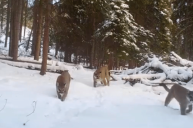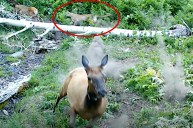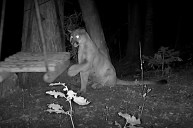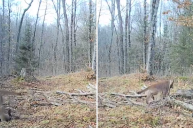In the Huachuca Mountains near Tucson, Arizona, a wildlife photographer recently caught a rare sight on his trail camera: A jaguar. Jason Miller shared the footage on his YouTube channel on January 3rd. In the video, Miller shared that seeing a jaguar is a dream he'd been following for the past five years.
Miller has seen many different animals on the his trail cameras. "I was fortunate enough to get an ocelot the last several years. Just north of the Mexico border in a deep canyon, on Dec. 30, I was hiking up checking some cameras. I set up some cameras overlooking this mountain lion scrape, hoping to get a lion." Instead, he got what he always hoped to see: his first jaguar.
In the footage, you can see the jaguar look up at the camera, snarling and baring his teeth.
At one point, jaguars could be found in Texas, California, Arizona and New Mexico. But their population dwindled in the states, while they remained in 19 other countries, including Mexico, Costa Rica, Honduras, and many other South American countries.
The last breeding pair of jaguars was recorded in Arizona in the 1960s. Consequently, jaguars have been on the U.S Fish and Wildlife Services endangered species list since 1997. But people have been seeing them appear in the states since 1996. Miller's jaguar is the eighth distinct specimen whose paws have graced U.S. soil. The southwestern states have had frequent sightings of the third-largest cat in the world. A jaguar was seen in 2017, 60 miles north of the border in Arizona. It was the third jaguar to be spotted at the time. Another was seen roaming the mountains within eight days of an ocelot in 2021, also in Arizona. The pair of males showed up in the Cabezas/Chiricahua Mountains, giving biologists hope both species would soon return to the area.
On top of the jaguar, Miller's trail cameras captured mountain lions, javelinas, a ringtail, and bears. But the crowning jewel of this footage will always be the gorgeous jaguar, who brings hope that the species will continue to grow.
READ MORE: Reintroduction of the Jaguar into the Lower 48 States Could Be Conservation's Next Big Project




